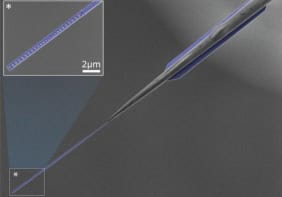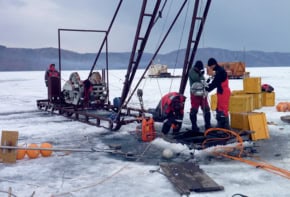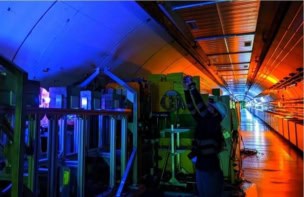
What do sand and quarks have in common? The answer, according to physicists in the US, is that they both behave like liquids under certain circumstances. When Sidney Nagel and colleagues at University of Chicago fired jets of sand-like granular materials at solid targets, some of the resulting spray patterns were very similar to what has been seen when heavy nuclei collide to produce a “quark-gluon plasma”. The discovery could shed light on why such a plasma appears to behave like a liquid rather than a gas – something that has puzzled physicists since the behaviour was first seen in 2005.
In their experiments, the team fired jets of tiny glass or copper beads at a solid cylindrical target and captured the resultant spray patterns using high-speed photography (Phys. Rev. Lett. 99 188001). They found that after hitting the target, the jet behaves like a liquid by spreading out in directions perpendicular to incoming jet. The team also discovered that when they used targets with diameters smaller than the diameter of the jet, the beads flowed around the target, creating a bell shape on the other side. It turns out that this is exactly what happens when a jet of water hits a similar target and such “waterbells” were first seen in the 19th century .
Rebounding particles
These sheets and bells of beads might seem odd if you think of the jet as a collection of independent particles, which would each strike the target and just bounce back. However, if the density of the jet is high enough, incoming particles can collide with rebounding particles in the region of the target and these collisions would cause the jet to behave like a liquid. According to Nagel, the incoming stream of particles creates a pressure on this “liquid”, causing it to squirt out in directions perpendicular to jet.
The team measured the angle between the initial direction of the jet and the final trajectories of the particles for a number of different targets with cross-sectional diameters both larger and smaller than the jet itself. They found that the relationship between the angle and target diameter was identical for jets made of glass or copper beads – and for water jets with high velocities. As a result, Nagel and colleagues concluded that the sand jets behave as a liquid.
Liquid-like plasma
Furthermore, Nagel and colleagues believe that this liquid-like behaviour of colliding particles has been seen before — at the Relativistic Heavy Ion Collider (RHIC) at Brookhaven National Laboratory in the US. Two years ago, researchers at the RHIC smashed together pairs of gold nuclei to create multi-particle “quark-gluon plasma”. Such a plasma is believed to be present in the early Universe – just before it has cooled enough for quarks and gluons to combine and form protons and neutrons.
The RHIC researchers were surprised to discover that the plasma behaved more like a liquid than a gas. This was evident when the nuclei underwent glancing collisions, which created rugby-ball or almond -shaped plasma that expanded more rapidly along certain directions. This came as a surprise because quantum chromodynamics (QCD) – the theory describing quark-gluon interactions — predicts that the plasma should behave like a weakly-interacting gas rather than a strongly-interacting fluid.
Nagel and colleagues tried to simulate the RHIC collisions by firing sand jets with a rectangular — rather than circular — cross section at a cylindrical target. This resulted in a liquid that also expanded in preferred directions. They measured this anisotropy using the same dimensionless parameter used to characterize the RHIC plasmas and found them to be very similar.
According to Nagel, the similarities between the two experiments mean that it could be possible to describe the liquid properties of the quark-gluon plasma in terms of the very rapid collisions of a dense collection of hard spheres – just like the particles in the jets of sand. “All physics is related”, he told physicsworld.com. “Studying one branch elucidates effects in a seemingly disconnected area of physics”.



